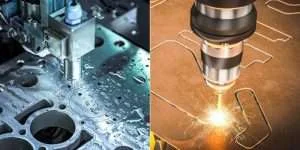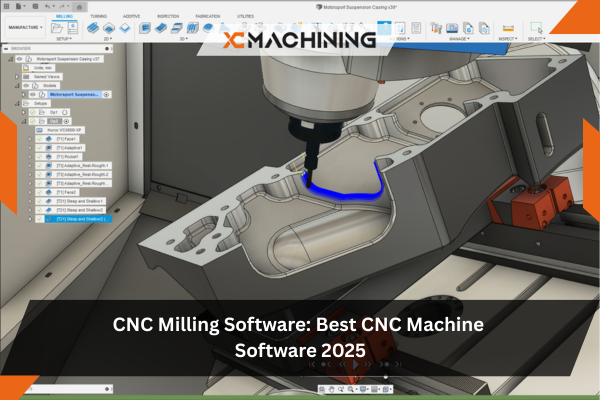CNC cutting vs Laser cutting are popular subtractive processes that machinists often use in shaping workpieces. However, specific characteristics such as their working principles mark their differences.
This article discusses the differences between CNC cutting vs Laser cutting and factors to consider when choosing between CNC cutting vs Laser cutting.
Main Differences between CNC Cutting vs Laser Cutting
The primary difference between these two technologies is their strategy for CNC cutting vs Laser cutting different materials into varying shapes. This section discusses their differences in detail.
Tooling
CNC cutting relies on mechanical tools and bits to carve into materials, utilizing friction in the process. In contrast, laser cutting involves the use of intense, high-temperature laser beams directed at the material. This fundamental difference means that each type of machine excels in specific situations, catering to distinct cutting needs.
There is a wide range of common CNC Machining tools. For example, drill bits are essential for creating holes, while milling cutters are useful in contouring, profiling, and slotting tasks. CNC cutting vs Laser cutting serve well for turning operations on cylindrical workpieces. Rotary cutting tools are employed to enlarge and finish existing holes to precise dimensions.
There are various methods used for laser cutting. Fiber laser cutting is ideal for cutting metals like brass, steel, aluminum, and copper due to its stability and power output. CO2 laser cutting, on the other hand, is effective for cutting organic materials and thin metal sheets. Nd: YAG laser cutting is versatile for cutting both metals and certain non-metallic materials.

Material Compatibility and Cutting Complexities
CNC cutting is ideal for machining extensive material ranges, including composites, metals, wood, and plastics. It is perfect for machining very thick materials and can handle simple or complex shapes and cuts. Thus, machinists use CNC cutting vs Laser cutting in heavy-duty applications requiring significant material removal.
Laser cutting is suitable for machining materials like metals, wood, plastics, etc. This technology is perfect for making intricate designs like sharp angles and curves without changing tools. CNC laser machines are ideal for processing fragile materials for multiple applications.
Speed
In terms of speed, CNC cutting vs Laser cutting tools have their advantages depending on the specific requirements of the project. Laser cutting can often cut through a wide range of materials in a single pass. This is particularly beneficial for thinner materials and can shorten processing time. However, as material thickness increases, the performance of laser cutters may reduce.
On the other hand, CNC cutting methods may require multiple passes, especially for thicker materials. This may extend the overall processing time. Nonetheless, when it comes to handling thicker workpieces, CNC cutting machines tend to outperform laser cutters.
Precision
The design phase is critical in achieving desired outcomes. It’s essential to consider the specific machine being used and tailor the design file accordingly to optimize the cutting process.
Most laser cutters boast impressive engraving or cutting accuracy, typically within the range of ±0.0004 inches (±0.01mm). This surpasses the ±0.004 inches (±0.1mm) accuracy typically associated with CNC machines.
Laser cutting can achieve precision cuts, especially for intricate designs involving corners and curves. It can effectively attain a radius as small as 0.1mm (0.004 inches). However, it may not be suitable for deep cuts. On the other hand, CNC cutting vs Laser cutting is capable of accurate cuts with radii ranging from 2mm to 0.08mm (0.08 inches to 0.003 inches).
Clamping Requirements
CNC machines rely on strong clamping methods to securely hold the workpiece in place. This ensures effective cutting force application for machining operations. These clamps are positioned directly over the workpiece’s surface. Therefore, you must carefully consider clamping placement and adjustments to the toolpath to prevent tool collisions.
In contrast, laser cutting is a non-contact process that doesn’t require substantial work holding for most materials. However, work holding may be necessary for lightweight and flexible materials like low-density foams. In such cases, options like double-sided tape can help prevent the material from shifting. The choice of work holding depends on the specific material and its characteristics.

Finish Quality
CNC machining typically yields rough cuts that often necessitate additional processing to achieve a desired surface finish. In contrast, laser rapid produce clean cuts with a high-quality surface finish. The process involves heating and melting the material, effectively sealing the cut edges. This results in a superior finish on the end product.
However, you should note that CNC cutting vs Laser cutting can sometimes result in burnt edges, which may not be desirable for specific applications.
Factors to Consider When Choosing Between CNC Cutting and Laser Cutting
Various considerations help decide the ideal technology when choosing betweenCNC cutting vs Laser cutting. Moreover, specific project requirements and materials influence your choice between these cutting techniques. Below are some of the crucial factors to consider.
Material Heat Sensitivity and Thickness
The sensitivity of the intended materials to heat is a fundamental factor to consider. Laser cutting emits concentrated heat, which may adversely affect the workpiece material. However, CNC cutting vs Laser cutting might be the ideal choice when fabricating heat-sensitive materials.
Besides, using laser cutters to machine thicker materials may be complicated since they cut thin sheets of material better.

Cost and Budget
Comparing the production machine installation, maintenance, and operating costs with each cutting technology is essential when choosing between CNC cutting vs Laser cutting. CNC cutting machines may have higher operational costs even though their initial costs might be lower. On the other hand, the upfront costs of laser-cutting machines may be expensive. Nonetheless, they might eventually become cost-effective for specific applications.
Complexity of Parts
The complexity of the intended part is a vital factor to consider whenever you need a cutting process. Laser-cutting machines offer the precision and speed required to machine complex and intricate patterns on parts. Conversely, CNC cutting may be well-suited for machining thicker materials to create parts with simpler shapes.
Lead Time
Consider your project’s lead time as you decide on the ideal cutting method. Laser-cutting machines are usually faster to set up than CNC machines. Therefore, CNC cutting vs Laser cutting machines are suitable for short production runs and rapid prototyping since they offer a shorter lead time.
Overview of CNC Cutting
What Is CNC Cutting?
CNC cutting involves the use of CNC machines that depend on physical cutting tools to shape a block of material into various simple or complex geometries. These machines often maintain close contact with the workpiece to fabricate the desired dimensions. In addition, manufacturers often employ the CNC cutting vs Laser cuttingprocess in adding fillet and chamfer to different parts.
These computer-controlled cutting tools, including drills, mills, and routers, follow a set of computer commands known as the G-code file. Machinists use various CNC software programs to handle various CAM, CAD, and control CNC cutting machine operations.

CNC Cutting Tools
CNC cutting tools are crucial for manufacturing procedures as other components since they determine work quality and product manufacturing. These tools can execute different cutting operations, including CNC engraving. However, the cutting tool type can influence the feed rate, spindle speed, and chip size cut from the workpiece.
Typical CNC cutting tools include:
Drill Bits
Drill bits or drilling tools are versatile cutting tools suitable for creating holes in workpieces when top CNC machines. Center, twist, spot, and specialized drills are typical CNC cutting vs Laser cutting for making specific hole geometries.
Milling Cutters
Milling cutters are practical tools for machining operations such as contouring, profiling, and slotting. CNC milling cutters usually have varying forms, like T-slot cutters, end mills, face mills, and shell mills.
Turning Tools
CNC cutting vs Laser cutting use turning tools in cutting operations to shape cylindrical workpieces by cutting material as the workpiece spins. Turning tools include inserts like carbide inserts, which are available in varying geometries for different turning tasks.
Reamer
A reamer is a rotary cutting tool with a cylindrical or conical structure commonly used to enlarge and finish existing holes to accurate dimensions. These reamers have tighter tolerance, providing exact diameter and precise finish in holes machined in workpieces.

Pros of CNC Cutting
- Uniformity: CNC cutting offers parts with matching design specifications without compromising quality. This technology provides the precision ideal for prototype and mass production.
- Low Labor Costs: CNC cutting technology involves the use of machines that require little to no operator intervention. As a result, one personnel can manage several cutting machines when handling jobs with longer cycle times, reducing labor costs.
- Continuous Operation: CNC cutting allows continuous machining operation, providing a high production rate and minimal production time.
- Versatile Applications: CNC cutting is highly applicable for various purposes in different industries, such as construction, engineering, art design, and architecture.
Cons of CNC Cutting
- Operator Error: Machine operator errors occur during CNC cutting vs Laser cutting, which may impact the accuracy of machined parts.
- Tool Presetting: Tool presetting is one of the significant constraints of CNC cutting. The technique requires mounting each tool in its holder for proper positioning, which can take longer.
- Design Limitations: You may encounter certain design constraints in CNC fixtures cutting since the method depends on computerized controls. Hence, it may be unsuitable for parts with irregular shapes.
Overview of Laser Cutting
What is Laser Cutting?
The laser cutting technique utilizes a laser beam to make precise cuts on workpieces instead of abrasive tools and physical contact. Generally, laser cutters use a computer-controlled laser head that concentrates a high-laser beam on the workpiece to make precise cuts.
The control software interprets the design and controls the laser head’s movement to trace the path of the desired pattern.

Types of Laser Cutting
Laser cutting comes in different types with varying materials and applications. Below are the typical laser cutting types.
Fiber Laser Cutting
Fiber CNC cutting vs Laser cutting cuts through materials using fiber-optic, a laser source that emits high-energy light beams. They are commonly used in cutting metals such as brass, steel, aluminum, and copper due to vibration stability and high output power.
CO2 Laser Cutting
The CO2 laser cutting technique involves using a high-powered carbon dioxide laser to cut materials. This laser-cutting type generates an infrared beam fueled by carbon dioxide gas to penetrate most organic materials. CO2 lasers are perfect for cutting thin metal sheets, woodworking, and laser engraving.
Nd: YAG Laser Cutting
Neodymium-doped yttrium Aluminum Garnet lasers use a solid-state laser instrument and generate a high-energy focused beam. This laser cutting is perfect for more specialized applications.
Nd: YAG Laser Cutting is compatible with various applications since it is ideal for cutting metals and certain non-metallic materials. Its typical applications include jewelry making, micro-machining, and medical device manufacturing.
Pros of Laser Cutting
- High Accuracy and Precision: CNC cutting vs Laser cutting provides components with high accuracy. It offers the tight tolerance needed in making different parts for the medical and aerospace industries.
- No-Contact Cutting: Laser cutting is a no-contact process that mitigates the risk of mechanical friction that could damage the workpiece.
- Quality: Laser cutters make clean and smooth cuts with little-to-no burrs or surface roughness. Therefore, parts machined by laser cutters don’t usually need post-processing operations.
Cons of Laser Cutting
- Metal thickness Limitation: Laser cutting is unsuitable for cutting thicker materials. Manufacturers only use laser machines to cut metals with low-to-moderate thickness.
- Safety: Laser-cutting procedures can pose certain safety risks if not adequately operated since they utilize high-powered lasers.
- Need for Expertise: The laser cutting methods often require an expert operator with knowledge of the technology to achieve the desired results.
- Toxic Fumes: The high-powered beam utilized in the laser cutting technique generates harmful gasses, especially when cutting plastic materials.
Applications of CNC cutting vs Laser cutting
CNC cutting vs Laser cutting technologies are compatible with various industries requiring precision cutting and workpiece shaping. Below are applications of laser cutting vs. CNC cutting.
CNC Cutting Applications
- Metal Fabrication: The CNC cutting technique fabricates metals like copper, aluminum, and steel. Aerospace, automotive, and construction industries often utilize CNC cutting in creating parts and components with tight tolerances.
- Plastic Fabrication: Manufacturers in many industries employ CNC cutting to make plastic products. These include displays, signs, and custom plastic products.
- Prototyping: Engineers and product developers rely on CNC cutting to make and test prototype designs before producing them in large quantities.

Laser Cutting Applications
- Jewelry Manufacturing: Laser cutting machines are well-suited for making complex and delicate designs in gemstones and precious metals when producing jewelry. Manufacturers use laser marking in creating custom products.
- Medical Devices: Manufacturers in the medical sector utilize laser cutting in producing surgical instruments, stents, and other medical devices due to their remarkable precision and low thermal effect on the material.
- Automotive Interiors: Automotive producers use laser cutting machines to make complex designs and patterns on interior components of vehicles, such as dashboard trim and leather seats.
XinCheng’s CNC and Laser Cutting Services
XinCheng is your one-stop machine shop for reliable CNC cutting vs Laser cutting services whenever you need a partner for projects. Our engineers and machinists possess the skills and experience to operate CNC machines and laser cutters to create precise, high-quality parts.
Contact us whenever you are uncertain of the proper cutting process for your parts between laser cutting and CNC. We are always ready to help you produce parts of different sizes and geometries with the ideal machining solutions.
Conclusion
CNC cutting vs Laser cutting are typical machining processes helpful in making parts with high accuracy and free from defects. However, choosing between these technologies parts is often challenging. Besides, both strategies have distinct benefits and limitations that you must consider when selecting the best cutting process for your workpieces. Therefore, it is essential to understand the differences between laser cutting and CNC to determine the best method for your project.
FAQs
Is CNC cutting faster than laser cutting?
Due to their incredibly high processing speed, laser cutters can cut through different materials in a single pass. Meanwhile, CNC cutting machines often require repeated passes to cut most materials. Besides, a laser can process materials at twice the speed of a typical CNC machine.
What is the standard cutting depth of laser cutting machines?
Although sophisticated laser cutters can penetrate materials with a thickness of 20 mm, a regular laser cutting machine can cut materials with a thickness range of 0.5 to 12 mm.
What are the limitations of laser cutting?
The release of toxic gasses and fumes, high upfront costs, and material thickness are typical limitations of laser cutting.





